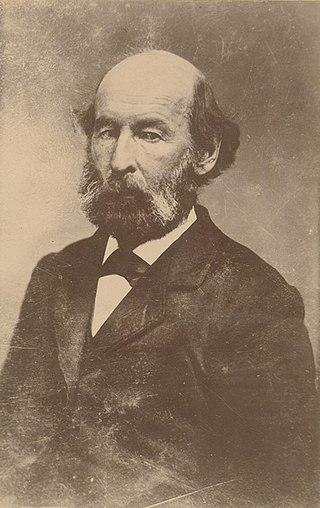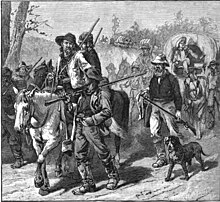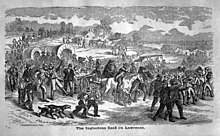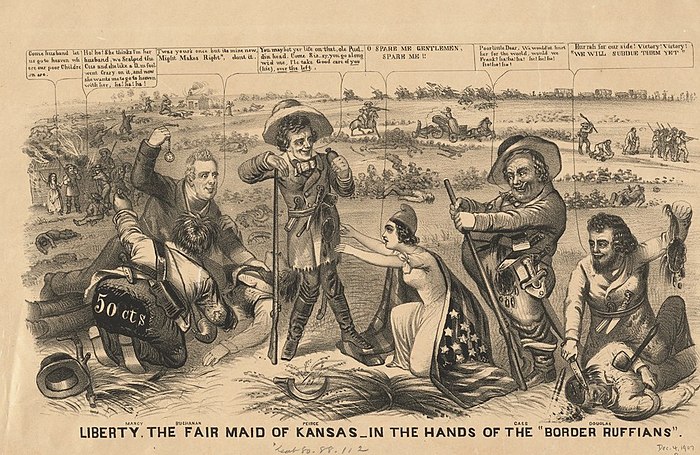
David Rice Atchison was a mid-19th century Democratic United States Senator from Missouri. He served as President pro tempore of the United States Senate for six years. Atchison served as a major general in the Missouri State Militia in 1838 during Missouri's Mormon War and as a Confederate brigadier general during the American Civil War under Major General Sterling Price in the Missouri Home Guard. Some of Atchison's associates claimed that for 24 hours—Sunday, March 4, 1849, through noon on Monday—he may have been Acting President of the United States. This belief, however, is dismissed by nearly all scholars.

The Kansas–Nebraska Act of 1854 was a territorial organic act that created the territories of Kansas and Nebraska. It was drafted by Democratic Senator Stephen A. Douglas, passed by the 33rd United States Congress, and signed into law by President Franklin Pierce. Douglas introduced the bill intending to open up new lands to develop and facilitate the construction of a transcontinental railroad. However, the Kansas–Nebraska Act effectively repealed the Missouri Compromise of 1820, stoking national tensions over slavery and contributing to a series of armed conflicts known as "Bleeding Kansas".

Bleeding Kansas, Bloody Kansas, or the Border War was a series of violent civil confrontations in Kansas Territory, and to a lesser extent in western Missouri, between 1854 and 1859. It emerged from a political and ideological debate over the legality of slavery in the proposed state of Kansas.

The Territory of Kansas was an organized incorporated territory of the United States that existed from May 30, 1854, until January 29, 1861, when the eastern portion of the territory was admitted to the Union as the free state of Kansas.

Jayhawker and red leg are terms that came to prominence in Kansas Territory during the Bleeding Kansas period of the 1850s; they were adopted by militant bands affiliated with the free-state cause during the American Civil War. These gangs were guerrillas who often clashed with pro-slavery groups from Missouri, known at the time in Kansas Territory as "Border Ruffians" or "Bushwhackers". After the Civil War, the word "Jayhawker" became synonymous with the people of Kansas, or anybody born in Kansas. Today a modified version of the term, Jayhawk, is used as a nickname for a native-born Kansan.

The sacking of Lawrence occurred on May 21, 1856, when pro-slavery settlers, led by Douglas County Sheriff Samuel J. Jones, attacked and ransacked Lawrence, Kansas, a town which had been founded by anti-slavery settlers from Massachusetts who were hoping to make Kansas a free state. The incident fueled the irregular conflict in Kansas Territory that later became known as Bleeding Kansas.

The New England Emigrant Aid Company was a transportation company founded in Boston, Massachusetts by activist Eli Thayer in the wake of the Kansas–Nebraska Act, which allowed the population of Kansas Territory to choose whether slavery would be legal. The Company's ultimate purpose was to transport anti-slavery immigrants into the Kansas Territory. The Company believed that if enough anti-slavery immigrants settled en masse in the newly-opened territory, they would be able to shift the balance of political power in the territory, which in turn would lead to Kansas becoming a free state when it eventually joined the United States.
The Wakarusa War was an armed standoff that took place in the Kansas Territory during November and December 1855. It is often cited by historians as the first instance of violence during the "Bleeding Kansas" conflict between anti-slavery and pro-slavery factions in the region.

Eli Thayer was a Republican member of the United States House of Representatives from 1857 to 1861. He was born in Mendon, Massachusetts. He graduated from Worcester Academy in 1840, from Brown University in 1845, and in 1848 founded Oread Institute, a school for young women in Worcester, Massachusetts. He is buried at Hope Cemetery, Worcester.

"Beecher's Bibles" was the name given to the breech-loading Sharps rifle that were supplied to and used by the anti-slavery settlers and combatants in Kansas, during the Bleeding Kansas period (1854–1860). The breech loading model 1853 Sharps Carbines were shipped in crates marked "Books and Bibles". After an 1856 article in the New-York Tribune carried a quote by Henry Ward Beecher, the Sharps Carbines became known as Beecher's Bibles.
Missouri Blue Lodges were secret proslavery societies formed in western Missouri during 1854 to thwart Northern anti-slavery plans to make Kansas a free state under the Kansas-Nebraska Act. They not only promoted the migration of proslavery settlers to Kansas but occasionally crossed the border to participate in the election of proslavery members to the territorial government.

Free-Staters was the name given to settlers in Kansas Territory during the "Bleeding Kansas" period in the 1850s who opposed the expansion of slavery. The name derives from the term "free state", that is, a U.S. state without slavery. Many of the "free-staters" joined the Jayhawkers in their fight against slavery and to make Kansas a free state.

At the outbreak of the American Civil War in April 1861, Kansas was the newest U.S. state, admitted just months earlier in January. The state had formally rejected slavery by popular vote and vowed to fight on the side of the Union, though ideological divisions with neighboring Missouri, a slave state, had led to violent conflict in previous years and persisted for the duration of the war.
The Battle of Osawatomie was an armed engagement that occurred on August 30, 1856, when 250–400 pro-slavery Border ruffians, led by John W. Reid, attacked the town of Osawatomie, Kansas, which had been settled largely by anti-slavery Free-Staters. Reid was intent on destroying the Free-State settlement and then moving on to Topeka and Lawrence to do more of the same. Abolitionist John Brown first learned of the raiders when they shot his son Frederick. With just 40 or so men, Brown tried to defend the town against the pro-slavery partisans, but ultimately was forced to withdraw; five Free-Staters were killed in the battle, and the town of Osawatomie was subsequently looted and burned by Reid's men. The battle was one of a series of violent clashes between abolitionists and pro-slavery partisans in Kansas and Missouri during the Bleeding Kansas era.

Charles Rainsford Jennison also known as "Doc" Jennison was a member of the anti-slavery faction during Bleeding Kansas, a famous Jayhawker, and a member of the Kansas State Senate in the 1870s. He later served as a Union colonel and as a leader of Jayhawker militias during the American Civil War.

Benjamin Franklin Stringfellow was a pro-slavery border ruffian in Kansas, when the slavery issue was put to a local vote in 1855 under the Popular Sovereignty provision.

Samuel Dexter Lecompte was an American jurist best known for his extreme pro-slavery views, his involvement in the events of Bleeding Kansas, and for being the founder and namesake of Lecompton, the erstwhile capital of the Kansas Territory.

The Marais des Cygnes Massacre Site, also known as Marais des Cygnes Massacre Memorial Park, is a state historic site near Trading Post, Kansas that commemorates the 1858 massacre of the same name. On May 19, 1858, during a period of political instability and sporadic violence known as Bleeding Kansas, a group of pro-slavery border ruffians captured 11 abolitionist free-staters. The prisoners were forced to a nearby ravine, where 10 of them were shot, resulting in five fatalities. The abolitionist John Brown later built a fort near the site. The first commemoration at the site was two stone markers erected by men of the 3rd Iowa Cavalry Regiment in 1864, although these monuments had been destroyed by souvenir hunters by 1895. In 1941, the land where the massacre occurred, as well as an 1870s-era house constructed by a friend of Brown, were transferred to the state of Kansas. The site was listed on the National Register of Historic Places in 1971 and designated a National Historic Landmark in 1974. The Kansas Historical Society administers the site, which is interpreted by signage and a hand-cranked audio recording.

Dunavant is an unincorporated community in Jefferson County, Kansas, United States.
John H. Stringfellow was an early physician of Kansas, one of the founders of Atchison, and speaker of the house in the first territorial legislature, the pro-slavery Bogus Legislature. He was born in Culpeper County, Virginia, son of Robert Stringfellow, a farmer, veteran of the War of 1812, merchant at Raccoon Ford on the Rapidan River, and Mary Plunkett, daughter of an early industrialist in Orange County, Virginia. Benjamin Franklin Stringfellow was his younger brother. He was educated at Caroline Academy, Va., Columbia University, and graduated from the medical department of the University of Pennsylvania in 1845. Soon after that he located at Carrollton, Missouri, where he married Ophelia J. Simmons, niece of Louisiana Governor John Bel Edwards.


![Ferrying Missouri voters [across the Missouri River] to the Kansas shore, by Gilbert Gaul Ferrying Missouri voters to the Kansas shore.jpg](http://upload.wikimedia.org/wikipedia/commons/thumb/8/82/Ferrying_Missouri_voters_to_the_Kansas_shore.jpg/220px-Ferrying_Missouri_voters_to_the_Kansas_shore.jpg)


















